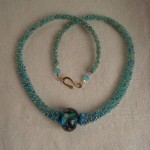
Spiral peyote choker
Today’s necklace features an Aura Sun Arts lampworked bead with blues and traces of gold.
The necklace is 16.5 inches long, and is strung on stainless steel beading wire, with a tube of spiral peyote stitch seed beads embellishing each side. The seed bead work is done with a tiny needle and upholstery thread. Click on the image for a larger view.
Weaving the beads and thread is somewhat like making running bond brickwork. You will have a string of beads with alternating beads standing taller, and you add the next bead between two tall neighbors. I have used seed beads of three different sizes here, which makes the pattern more free form.
The Wikipedia article on brickwork has some interesting terminology for bricks, like soldier, sailor, shiner and stretcher; all names for how the bricks are placed in the wall.
The bead weaving is a slow process which makes this style more expensive, resulting in a price range of $90.00 to $120.00 for this one or similar necklaces.
After a summer of bead making, when the cooler weather arrives, it is time to string up your creations into wearable jewelry. There are so many ways to do this, but the very simplest is to wear a bead on a ribbon or leather cord. Another easy way is with flexible beading wire and crimping tools. With a crushable tube of silver (a crimp bead) you can secure the wire to the end clasps to finish your strand.
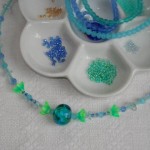
Finished strand of beads with loose seed beads
Here I have a blue green center bead I made with some companion beads – seed beads and some slightly larger beads for more color and contrast.
A variation on this would be to have three or more strands of smaller beads holding that larger center bead, the multi-strand necklace. Next time I will have a knit tube of seed beads forming the necklace to show off, stay tuned.
The new Aura Sun Arts glass studio is nearly ready for action.
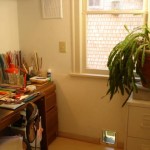
new studio in a sunny corner
I have the glass canes in easy reach, and ones in current use arrayed on a hotplate. A second hotplate on the left out of view keeps the finished beads warm as they slowly cool down, a process called annealing. The sunny window will give me plenty of ventilation, as will the fan. I still need a warm enough day to keep the glass happy.
Now that I am back in Seattle I will have to make a pilgrimage to the Tacoma Museum of Glass. I saw a delightful special on Evening Magazine featuring their exhibit of glass designed by children. 52 different fantastical sketches by children were made up into finished pieces by the glass professionals, who had a great deal of fun in the process.
The links above will show you a video and a slide show of some of the featured work. Here is a cucumber guy by kdg.

kdg-cucumber
How does one make a lampworked glass bead?
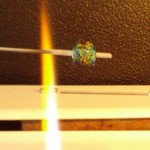
half made bead
Take a steel rod of 2 – 3 mm diameter, coated with a clay release agent, and heat up this rod in the flame. With the other hand, select a glass rod of the color needed, and introduce this slowly to the flame as well. The end of the glass rod will begin to melt, and form a blob, or “gather.” Drip this onto the rod, and wrap it around. Click on the photo for a larger view.
I usually marver the bead now, by rolling it on a flat surface until it takes a cylinder shape, and use this as my canvas to paint with more colors. I keep adding layers of color, and often finish the bead with some clear glass encasing.
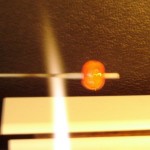
fully molten bead
The bead can be rather lumpy at this point, like a raspberry. I heat it up further until it is entirely molten, and takes on a smooth rounded shape. You must continually rotate the rod to keep the bead centered. If you wish the bead to be textured you skip this rounding. The bead can also be shaped by rolling it on a flat surface, or pressing it into a mold.
Then let it cool down until the normal colors return to the glass, and put it away in a kiln or warming thermal blanket to rest for several hours. The next day it can be taken off the rod: after a soak the clay rinses away and it twists free, the bead is complete and the rod can be re-coated with clay for the next dance.
The flame is a Minor lampworking torch with a mixture of propane and oxygen fuel. Proper ventilation and didymium safety glasses are essential. Wikipedia has several good entries relating to beadmaking and glass art.
Click on any photo here for a larger view.
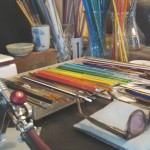
torch, glass rods, and safety glasses
Tags: beads, clay, color, didymium, encasing, glass, handmade, lampwork, marver, molten, thermal, torch
 AuraSunArts, making glass beads | mary |
AuraSunArts, making glass beads | mary |  July 18, 2010 3:09 pm |
July 18, 2010 3:09 pm |  Comments (0)
Comments (0)
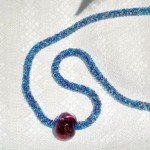
tubular seed beads with focal bead
There are many different styles for stringing beads into finished pieces. These are not for sale, but are examples of my work.
This one shows a focal lampworked bead with a choker made of seed beads, woven in peyote stitch into a tube. Mo approved. These will be fun to make in a rainbow of colors.
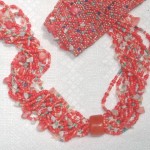
multicolored multistrand
…
On the left is a set of multicolored seed beads; coral, turquoise, deep blue, with chips of opal and chunks of coral interspersed. The multistrand necklace has a coral focal bead, and the peyote stitch bracelet has coral buttons. Click to see entire view.
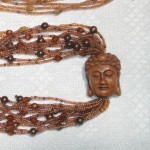
brown buddha
…
On the right, is a multistrand seed bead necklace in a gradient of browns, interspersed with brown pearls and larger brown faceted glass beads. Click to see the matching earrings. I did not carve the lovely boxwood Buddha bead, the signature on the back might be Japanese.
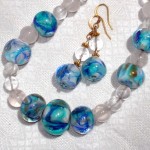
best of 2008 blues
…
Lastly, a single strand that has the best of the blue beads I made in 2008 during classes at Glass Expressions, in Burien, WA. The clear and frosty beads are quartz. Also shown are matching earrings.
Click on any of the photos for a larger view.
Tags: beads, bracelet, earrings, glass, gradient, handmade, necklace, peyote, seed, stitch, stringing
 AuraSunArts, private reserve, seed beads | mary |
AuraSunArts, private reserve, seed beads | mary |  June 27, 2010 2:13 pm |
June 27, 2010 2:13 pm |  Comments (0)
Comments (0)
Blue has to be one of my favorite colors.
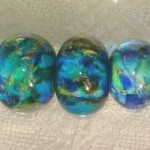
oceanic blues and greens
Blue glass beads can remind one of the fabulous colors of the ocean. Tropical waters are very clear, with little plankton, and the water is clear all the way down to the sandy bottom, showing off those gorgeous turquoise tints. Northern waters, with richer plankton, are a dark blue green.
When you paint with watercolors, you can combine or layer colors to blend and mix until you achieve new colors. Glass is much the same, so start with a sandy layer, then add pale blues and greens, deeper blues, some flotsam, jetsam, and a few bubbles, and you can almost imagine yourself snorkeling, rocking in the ocean to the sound of your breathing.
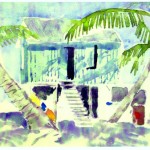
watercolor painted in Belize
Click on the photo to see more big blues. Those with a layer of clear glass on the outside – “encasing” – have an extra sense of depth. This layer refracts and bends light just as water does. Quite a few of these are matched pairs or sets. See all the blue beads on the Blue oceans page. Other new sets are featured on the Earrings page.
Tags: AuraSunArts, beads, blue, breathe, bubbles, color, depth, earrings, encasing, glass, gorgeous, ocean, paint, pair, refract, sand, turquoise, water, watercolors
 AuraSunArts, making glass beads | mary |
AuraSunArts, making glass beads | mary |  June 6, 2010 1:01 pm |
June 6, 2010 1:01 pm |  Comments (0)
Comments (0)












